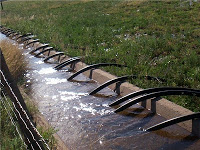**This article is not a substitute for the advice of an attorney.**
Thank you all for your comments and emails about last week’s blog post on the basics of surface water law in Texas. With that background, today we will turn to discuss several current issues related to surface water.
1. The Whooping Crane Case. A case currently pending in the United States Court of Appeals for the Fifth Circuit could greatly impact surface water law in Texas. Aransas Project v. Shaw surrounds decisions made regarding allocation of water in the Lower Colorado River Basin. Environmental groups filed suit against the Texas Commission on Environmental Quality (“TCEQ”) alleging that by issuing permits allowing diversion from the upstream portion of the river, which allegedly did not allow enough downstream flows and caused the death of 23 whooping cranes, the TCEQ violated the federal Endangered Species Act. The Endangered Species Act prohibits “taking” an endangered species, which includes killing or injuring the animal. The TCEQ argued two main points in response. First, the TCEQ argued there was no showing of proximate cause between the issuance of permits and the death of the birds. Second, the TCEQ argued that as a state agency it is not charged with enforcing the federal Endangered Species Act and, therefore, the TCEQ is under no obligation to ensure Texas water users comply with the Act.
The trial court judge found in favor of the plaintiffs, holding the TCEQ violated the endangered species act and issued an injunction prohibiting any new permits from being issued for water diversion from the river. The TCEQ appealed both the injunction and the decision. The Fifth Circuit issued a stay of the injunction, meaning until the case is decided the TCEQ may continue to issue permits. Oral argument on the merits of case was held August 2, 2013, and the parties are now awaiting a decision.
Why does this matter? This case could have broad implications in Texas and across the nation. If upheld, the TCEQ could be forced to change its decision-making process when issuing surface water permits and consider the effect its decisions would have under the Endangered Species Act, and the TCEQ could be barred from issuing permits in certain basins such as the Lower Colorado. Moreover, the broader impact of this decision could have broader impacts on federalism generally by forcing state officials to enforce federal laws.
2. The Brazos River Battle. In December, 2012, the Texas Farm Bureau filed suit against the TCEQ for actions taken by the agency related to permits for diversions of water from the Brazos River. During the recent drought, the TCEQ, relying upon the Texas Water Code Section 11.053 (which allows emergency orders to be issued concerning water rights), issued an order curtailing the right to divert surface water for permit holders along the Brazos. The TCEQ, however, made an exception for two types of permit holders: Municipalities and Power Generators. In allowing this exception, the TCEQ essentially disregarded prior appropriation because it curtailed the rights of many senior water holders, including numerous farmers who had senior irrigation permits, while allowing junior municipalities and power generators to continue pumping. TCEQ offered no form of compensation to the farmers and others with rights that were prohibited from using any surface water.
The Texas Farm Bureau filed suit challenging the authority of the TCEQ to make exceptions to the prior appropriation doctrine for certain classes of users. The trial court sided with the Farm Bureau, holding the TCEQ lacked the authority to make these exceptions to the prior appropriation doctrine under Section 11.053. This case is currently in appeal before the Corpus Christi Court of Appeals. During the appeals process, the trial court ruling will be suspended, meaning the TCEQ is allowed to continue following the rules allowing for the exception to prior appropriation until the Court of Appeals issues its decision.
Why does this matter? This case is important to determine whether the TCEQ has the authority under Section 11.053 to circumvent the prior appropriation system in times of drought, and thereby curtail or temporarily suspend water rights of certain types of users, while allowing other types of users holding junior water rights to continue diverting water.
3. What are “waters of the United States?” This is a federal issue impacting the scope of the Environmental Protection Agency (“EPA”)’s jurisdiction over certain waterways. Generally, water allocation and water quality issues are reserved to the individual states. If, however, the waters at issue are “waters of the United States,” then the EPA has jurisdiction over water quality issues and the federal Clean Water Act is applicable. Previously, the EPA issued a guidance document–meaning it was not an official agency rule and did not have to go through the official rulemaking process–defining this term. [Review guidance document here.] Recently, the EPA and the Army Corps of Engineers jointly released a draft scientific report addressing the issue of how waters of the United States should be defined, and the EPA is currently seeking public comment on this study. [Read report here and notice of public comment here.]
Further, based upon this study, the EPA has prepared a draft rule that has been submitted to the Office of Management and Budget for review. The proposed rule is not yet available for public rule or comment, although EPA spokespeople have indicated the rule will not make changes to existing permitting exceptions under the Clean Water Act applying to agriculture, including exceptions for agricultural storm runoff, silvicultural activities, irrigation ditches. According to the EPA, the purpose of the proposed rule is to “provide greater consistency, certainty, and predictability nationwide by providing clarity for determining where the Clean Water Act applies and where it does not.”
Why does this matter?: This issue is important because it will affect the reach of federal authority under the Clean Water Act. If the rule eventually passed by the EPA is broad, it could increase the jurisdiction of the EPA and the scope of the Clean Water Act. This could impact states, including Texas, by imposing additional federal laws on certain bodies of water. Many legal scholars expect the rule will be written extremely broad and will provide additional jurisdiction for the federal government. [Read example here.]
4. Matagorda Bay Cut Off. As was previously mentioned on this blog, the Lower Colorado River Authority recently requested permission from the TCEQ to curtail releases of water into Matagorda Bay for at least 120 days due to low water levels in Lake Travis and Lake Buchannan. The TCEQ has yet to act on the LCRA’s request.
Why does this matter? The Matagorda Bay is home to numerous species of wildlife and without the continued water flow from the Colorado River, the health and existence of these animals may be threatened. On the other hand, the LCRA is concerned that without curtailment, there may not be sufficient water to provide the domestic needs for cities including Austin.
5. Texas v. New Mexico. This issue has previously been discussed in great detail on this blog (click here). Essentially, Texas and New Mexico are embroiled in a dispute regarding allocation of waters of the Rio Grande. Texas claims New Mexico is diverting water belonging to Texas pursuant to a 1938 Compact, both by allowing stream diversions and underground pumping between the Elephant Butte Reservoir and the Texas state line. According to former TCEQ Commissioner and current Texas Water Development Board Chairman, Carlos Rubenstein, the impact from these activities last year was over 200,000 acre-feet of water and the total impact on Texas from the 1950’s to the present time is over 14 million acre-feet. Currently, a Motion for Leave to file a Complaint is pending before the United States Supreme Court and Texas continues to wait and see if the Court will agree to hear the case. Rubenstein told the audience at a recent Texas Public Policy Foundation event he expects a decision from the Supreme Court on whether it will hear the case within the next month.
Why does this matter? The water allocated to Texas under the compact is used for irrigation near El Paso, but is also a primary source of drinking water for the City of El Paso’s population of over 750,000 residents.
6. United States v. Mexico. This dispute has also been previously discussed on the this blog (click here). In its most rudimentary form, Mexico is behind on providing water as required by an international treaty between the two countries to allocate water between Mexico and southern Texas. Although Mexico has provided some additional water in the past months, as of September 21, 2013, a deficit of 339,244 acre-feet of water owed to the United States by Mexico. Currently, bills are pending in the United States Congress seeking to involve the United States Department of State and withdraw assistance to Mexico if the country fails to comply with its obligations under the Treaty.
Why does this matter? Many farmers in southern Texas rely upon the water from Mexico in order to irrigate their crops. In light of the ongoing drought, the lack of water has been disastrous for farmers. According to estimates, the lack of water could cost south Texas farmers $395 million in economic output and 5,000 jobs could be lost.
Stay tuned in the coming weeks for blogs on the basics of groundwater law in Texas and on current issues in groundwater law.


















